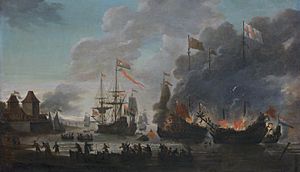Second Anglo-Dutch War facts for kids
Quick facts for kids Second Anglo-Dutch War |
|||||||
|---|---|---|---|---|---|---|---|
| Part of the Anglo-Dutch Wars | |||||||
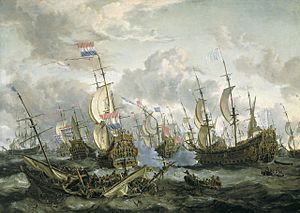 The Four Days' Battle, 1–4 June 1666, by Abraham Storck |
|||||||
|
|||||||
| Belligerents | |||||||
| Commanders and leaders | |||||||
|
|
||||||
| Strength | |||||||
|
|
||||||
| Casualties and losses | |||||||
|
|
||||||
The Second Anglo-Dutch War was a big fight between England and the Dutch Republic from 1665 to 1667. Both countries wanted to control important sea routes and trade around the world. England hoped to stop the Dutch from being the main trading power in Europe.
This war was the second in a series of naval battles between England and the Dutch in the 1600s. Even though England had some early wins, the war ended with a Dutch victory.
Contents
Why Did the Second Anglo-Dutch War Happen?
Rivalry Between England and the Dutch
Many historians believe the first and second Anglo-Dutch Wars happened because of trade and sea rivalry. While trade tensions were a big reason, some English politicians and navy officers also pushed for war. They stopped peace talks from happening.
There were also religious and political differences. English royalists (who supported the king) and Dutch republicans (who believed in a republic) saw each other as threats. This made it hard to agree.
After the First Anglo-Dutch War ended in 1653, the Dutch started using smaller warships and privateers (private ships allowed to attack enemy ships). This hurt English trade. Oliver Cromwell, England's leader, wanted peace. He asked that no member of the House of Orange (a powerful Dutch family) could hold public office. This demand was later dropped from the public peace treaty.
However, a secret agreement was made. The province of Holland agreed to pass a law, the Act of Seclusion, to keep the House of Orange out of public office. This made many people in other Dutch provinces upset, but the law was passed in Holland.
The English government under Oliver Cromwell wanted to avoid more fighting with the Dutch. They were planning a war with Spain. They feared the Dutch might help Spain. But the Dutch leader, Johan de Witt, wanted neutrality so Dutch trade could grow. He believed the Netherlands could not win a long war against England or France.
The Dutch used the years of peace to rebuild their trade fleet. They also built many new warships. These ships were stronger and had bigger guns than before. However, many were still small and meant for protecting trade, not for big sea battles. The Dutch East India Company also built ships that could carry goods or fight.
England had won most naval battles in the First Anglo-Dutch War. But they did not win the war itself. The Dutch were in a better financial spot. They could replace their lost ships faster than England. The Dutch also expanded their trade routes while English trade struggled. This made another war seem likely.
England's Situation Before the War
Trade Challenges for England
After the First Anglo-Dutch War, England fought a war with Spain (1654–1660). This hurt England's trade with Spain and Italy. The Dutch were free to expand their trade in these areas. This time was a high point for the Dutch Golden Age.
England's trade system relied on rules like the Navigation Acts, which tried to protect English trade. The Dutch system was more about free trade in Europe. Dutch goods were cheaper worldwide because the Dutch taxed their own people, not foreign buyers. The end of the first war did not change this. So, many people thought another war was unavoidable.
The Return of King Charles II
When Charles II became king in 1660, many in England hoped to reverse Dutch trade dominance. At first, Charles wanted to be friends with the Dutch. He owed money to the House of Orange.
But problems soon arose over the education of William III of Orange, Charles's nephew. William was named a "Child of State," meaning he would be trained for high office. When William's mother, Mary, died, Charles became William's guardian. This gave England some influence in Dutch politics.
The Dutch tried to please King Charles with gifts. They signed a treaty in 1662, where the Dutch gave in on most points. In 1663, Louis XIV of France claimed parts of the Spanish Netherlands. This brought England and the Dutch closer for a short time.
However, things changed in 1664. King Charles's brother, James, Duke of York, and other powerful politicians wanted to stop Dutch trade. James was head of the Royal African Company. He hoped to take over Dutch trading posts, including New Amsterdam in North America.
This aggressive plan was supported by the English ambassador in The Hague, Sir George Downing. He told Charles that the Dutch were divided and would give in to English demands. Even after England started seizing Dutch ships, Downing reported that the Dutch would likely accept less overseas trade.
Charles was influenced by James and others. He wanted a popular and profitable war at sea to strengthen his power. Many naval officers also wanted war, hoping to become famous and rich.
Building Up for War
As excitement for war grew in England, privateers joined navy ships in attacking Dutch vessels. They captured about 200 Dutch ships before the Dutch declared war. The new treaty said Dutch ships had to salute the English flag first. In 1664, English ships started provoking the Dutch by not saluting back.
In late 1663, James sent Robert Holmes to protect English interests. Holmes captured a Dutch trading post in West Africa in June 1664. He also took several Dutch West India Company ships. England refused to pay for these actions. Slightly later, the English invaded the Dutch colony of New Netherland in North America in June 1664 and took control by October.
The Dutch government sent a fleet led by Michiel de Ruyter. He recaptured their African trading posts and took most English trading stations there. Then, he sailed to North America to attack the English.
In December 1664, the English attacked the Dutch Smyrna fleet. The attack failed. In January 1665, the Dutch allowed their ships to fire on English warships in the colonies if threatened. Charles used this as an excuse to declare war on the Netherlands on March 4, 1665.
De Ruyter was stopped at Barbados in April 1665. He then captured English ships and delivered supplies to a Dutch colony. He decided not to attack New York (formerly New Amsterdam) because his ships were damaged. De Ruyter then went to Newfoundland, capturing English merchant ships and taking St. John's before returning to Europe.

English propaganda used the old Amboyna Massacre of 1623 to stir up support for the war. In that event, Dutch agents had executed English traders in Indonesia. This incident had caused a big crisis between the two countries. Pamphlets were written to remind people of this event.
Another reason for conflict was trade competition. English trading companies had lost business in the 1650s. They blamed illegal trade and Dutch competition. They wanted the government to stop the Dutch from trading with British colonies. The Dutch, who were big in international trade, supported free trade where it helped them. But they kept strict control in their own colonies.
Dutch Republic's Readiness for War
After their loss in the First Anglo-Dutch War, the Dutch prepared much better. From 1653, Johan de Witt planned a "New Navy." It would have 64 new, heavier ships with 40 to 60 guns. They also planned 90 smaller ships for protecting trade. More professional captains were hired.
However, even the heavier Dutch ships were still lighter than England's biggest ships. In 1664, when war seemed likely, the Dutch decided to build even heavier ships. But when the war started in 1665, most of these new ships were still being built. The Dutch only had four heavy ships ready.
By the time of the Battle of Lowestoft, the Dutch fleet included 18 older warships and some very large ships from the Dutch East India Company. These company ships could carry cargo or fight, but they were not as strong as pure warships.
During the war, the Dutch Republic was in a better financial position than England. They quickly finished building new ships. They ordered and built 20 more. England, however, could only build about 12 ships due to money problems. De Witt knew that skilled sailors were more important than just ships. He tried to improve discipline among captains.
In 1665, England had about four times more people than the Dutch Republic. But most English people were poor farmers. The Dutch had more people living in cities. This meant the Dutch could spend more than twice as much money on the war as England.
The war started just before the Great Plague of London and the Great Fire of London. These disasters hit London, England's main city. This weakened England greatly. The English fleet already had money problems. Even though Parliament approved a large budget, Charles II struggled to collect taxes. He relied on loans, which became more expensive.
Sailors were often paid with "tickets" (debt certificates) instead of cash. This caused delays and problems. Capturing Dutch merchant ships was a way to get money for the English navy. But this was not a steady income. Dutch privateers became more successful later in the war.
France's Role in the Conflict
France and the Dutch had a treaty from 1662. It said they would defend each other. This meant the Netherlands would be protected from an English attack. It also meant the Dutch would not help Spain.
Louis XIV of France thought an Anglo-Dutch war would mess up his plans to take land from Spain. Charles II's ambassador in France reported that France did not want the war. This made Charles hope that if the Dutch declared war, France would not help them.
In 1664, Louis tried to stop the war or keep it to Africa and America. These efforts failed. The war began when the Dutch declared war on March 4, 1665. This happened after English attacks on Dutch ships.
Even after the war started, Louis tried to avoid fighting England. He sent more ambassadors to London to try and make peace. They offered to return captured ships and trading posts. But they did not suggest returning New Netherlands. The Dutch complained about this.
Key Battles and Events of the War
First Year: 1665 Battles
At the start of the war, both sides wanted a quick, decisive battle. England's government could not afford a long war. An English blockade of Dutch ports would ruin their economy. Johan de Witt pushed the Dutch commander, Jacob van Wassenaer Obdam, to find the English fleet and fight.
In their first big fight, the Battle of Lowestoft on June 13, 1665, the Dutch suffered their worst defeat. They lost at least 16 ships, and one-third of their sailors were killed or captured.
However, the English could not fully use their victory. Most of the Dutch fleet escaped. Johan de Witt joined the fleet himself to restore confidence. He punished captains who failed. Michiel de Ruyter was made the new leader of the Dutch fleet in July 1665. He created new tactics. The Dutch Spice Fleet from the East Indies managed to return home safely after the battle of Vågen. This helped the Dutch financially.
In the summer of 1665, the bishop of Münster, Bernhard von Galen, invaded the Dutch Republic. England had promised him money. At the same time, England tried to make friends with Spain. Louis XIV of France was worried about Münster's attack and a possible English-Spanish alliance. He feared this would affect his plans to conquer the Spanish Netherlands.
Louis tried to mediate peace again. The French offered to accept the loss of New Netherlands and some West African posts. But the English victory at Lowestoft made Charles II reject this. He demanded more land and that the Dutch pay for the war. When Charles refused a French offer in December 1665, Louis withdrew his ambassadors. This showed he planned to declare war.
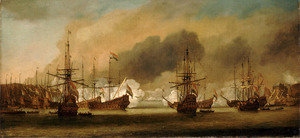
These events worried the English court. They feared the Dutch Republic might become part of the Spanish or French empires. This would be bad for England. Charles II ordered his minister, Clarendon, to make peace quickly.
At the end of 1665, secret talks began between the Dutch and English. Johan de Witt knew about these talks. He was unsure if Charles truly wanted peace. Scotland also joined the war in 1665, with Scottish privateers capturing many Dutch, French, and Danish ships. Scotland's location helped them attack ships avoiding the English Channel.
After the Battle of Lowestoft, Louis XIV worried that a destroyed Dutch fleet would let England interfere with his plans. He offered to mediate again, but England refused. Louis declared war on England on January 16, 1666. The anti-English alliance grew stronger. In February, Frederick III of Denmark also declared war after getting money from France.
By spring 1666, the Dutch had rebuilt their fleet with much heavier ships. Thirty of them had more cannons than any Dutch ship in early 1665. The Dutch threatened to join forces with the French fleet. The French planned to bring their Mediterranean fleet to join the Dutch in the English Channel. This would outnumber the English fleet.

An English fleet of about 80 ships sailed in late May 1666. It was led by the Duke of Albemarle and Prince Rupert. Rupert was sent with 20 ships to block the Strait of Dover and stop the French fleet from joining the Dutch. However, the French fleet did not appear. They were delayed in Lisbon.
The English and Dutch fleets then fought the Four Days' Battle. This was one of the longest naval battles in history. Albemarle found De Ruyter's fleet of 85 ships at anchor and attacked immediately. The battle was fierce and lasted until nightfall. On June 2, Albemarle had only 44 working ships. He continued fighting, but his fleet was too damaged. He retreated towards the Thames Estuary, with the Dutch following.
The next day, Albemarle protected his damaged ships with his strongest ones. Prince Rupert returned with his 20 ships and joined him. During this part of the battle, an English admiral, George Ayscue, surrendered his ship. This was the last time an English admiral surrendered in battle. With Rupert's help, Albemarle had 52 ships against the Dutch's 57. De Ruyter won the battle on the fourth day with a surprise attack.
Both sides claimed victory. The English said the Dutch retreated first. The Dutch said they caused more losses to the English. The Dutch lost four ships, while the English lost ten. The Dutch claim seems more accurate. However, their joy was too great for what they achieved. It took them four days to fight a weaker English fleet. Their belief that the English fleet was destroyed was proven wrong weeks later.
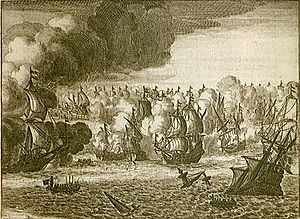
One more major sea battle happened: the St. James's Day Battle on August 4 and 5. England won, but the war was not decided. The Dutch fleet escaped, though they had many casualties. For the Dutch, just surviving was enough. England could barely afford to replace its losses, even after a victory.
After the Fire of London in September, the English navy could not pay its sailors. Many sailors were let go without pay. This made it impossible to send out a large fleet in 1667. Peace talks began in March. Charles II was ready to make some concessions. But he still wanted the nutmeg island of Pulau Run and some payments. The Dutch did not want to give in, but talks continued.
Scottish privateering greatly increased in 1666. They captured many Dutch, French, and Danish ships. Scotland's location was good for this. Many Dutch merchant ships were poorly armed.
Third Year: 1667 and the End of the War
The Raid on the Medway

By early 1667, England's money situation was terrible. The kingdom did not have enough funds to keep its fleet ready for sea. In February, it was decided that the heavy ships would stay docked at Chatham. Only a small "Flying Fleet" would attack Dutch merchant ships. This lowered morale and made it risky for English merchant ships to sail.
Clarendon told Charles II he had two choices: give in to Parliament's demands or start peace talks with the Dutch on their terms. Talks began in March. Charles wanted the talks in England or The Hague. But the Dutch offered other cities where support for the House of Orange was less. Charles chose Breda.
Meanwhile, a Dutch fleet gathered. One goal was to destroy Scottish privateers. The Dutch fought some Scottish privateers and shore batteries, but they were driven off. In southern Britain, things went worse for England.
Charles also sent envoys to Paris for secret peace talks with France. In April, Charles made a secret treaty with Louis XIV. England agreed not to join alliances against France's plans to conquer the Spanish Netherlands. In May, the French invaded, starting the War of Devolution. Charles hoped to delay talks at Breda. He wanted to get his fleet ready and use the French advance to get better terms from the Dutch.
Johan de Witt knew Charles's general plans. He decided to try and end the war with one big move. The Dutch navy had studied landing operations. The Dutch Marine Corps was created in 1665. After the Four Days' Battle, Dutch marines were ready to land in England if the Dutch won at sea. But the Dutch fleet could not get into the Thames River then.
Now, there was no English fleet to stop an attack. De Witt planned a landing of marines at Chatham, where the English fleet lay unprotected. His brother, Cornelis, would oversee it.
In June, De Ruyter, with Cornelis de Witt watching, launched the Dutch raid on the Medway. After capturing a fort, the Dutch fleet broke through a huge chain protecting the river. On June 13, they attacked the English fleet.
This daring raid was one of the biggest disasters for the Royal Navy. Fifteen English ships were destroyed. Some were burned by the Dutch, others sunk by the English to block the river. Three of England's biggest ships were burned. The largest English flagship, HMS Royal Charles, was captured without a fight. It was towed back to the Netherlands as a trophy. Its royal arms decoration is now in the Rijksmuseum. Luckily for England, the Dutch marines did not destroy the Chatham Dockyard, England's largest industrial complex. A land attack on the docks would have set back English naval power for a generation.
The Dutch success had a big psychological impact in England. London felt very vulnerable, especially after the Great Fire of London the year before. However, the Dutch could not land large forces in Britain. The raid, along with England's money problems, sped up peace talks. All these issues, plus the cost of the war and Charles's spending, created a rebellious mood in London. Charles feared a revolt. Clarendon ordered the English envoys at Breda to sign a peace treaty quickly.
War in the Caribbean Islands
The Second Anglo-Dutch War also spread to the Caribbean islands. In late 1665, an English force captured the Dutch islands of Sint Eustatius and Saba. Another English force took Tobago.
When France declared war on England and joined the Dutch, the power balance in the Caribbean changed. The French recaptured Tobago in August 1666. The Dutch and French together recaptured Sint Eustatius in November 1666. The French also took the English island of Antigua. This left only Nevis in English hands among the Leeward Islands.
A Dutch force arrived in February 1667 and captured Suriname from the English. The Dutch commander, Abraham Crijnssen, then sailed to Tobago. He rebuilt the fort there. In May, Crijnssen and the French commander, de La Barre, tried to invade Nevis. But their attack was stopped by a smaller English force. This battle was confusing and failed partly because of de La Barre's mistakes.
After this, Crijnssen left and sailed north to attack the Virginia colony. The French moved to Martinique. The Battle of Nevis helped England regain control in the Caribbean. They soon recaptured Antigua and Montserrat.
In April, a new English fleet arrived in the West Indies. On July 6, they attacked the French fleet at Martinique. They sank, burned, or captured most of the French ships. With the French fleet out of action, the English then attacked and captured Cayenne and Suriname. News of these English victories reached England in September, after the peace treaty was signed. Possessions captured after July 31 had to be returned.
The Treaty of Breda Ends the War
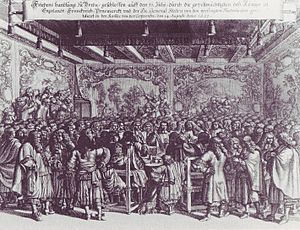
On July 31, 1667, the Treaty of Breda officially ended the war between England and the Netherlands. The treaty allowed England to keep New Netherland (which became New York). The Dutch kept control over Pulau Run and the valuable sugar plantations of Suriname. They also got back Tobago, Sint Eustatius, and their West African trading posts. This "as things are" solution was later confirmed in another treaty.
The Act of Navigation was changed to help the Dutch. England agreed to treat Germany as part of the Netherlands' trade area. This meant Dutch ships could now carry German goods to English ports.
On the same day, England and France also signed a public treaty at Breda. England got back its former parts of St Christopher, Antigua, and Montserrat. England gave up its claim to Acadia to France. This public treaty followed a secret treaty signed in April. In that secret treaty, Louis XIV and Charles II agreed not to form alliances against each other's interests. This helped Louis secure England's neutrality in his planned war against Spain.
It might seem strange today that the Dutch gave up what would become a big part of the United States. Instead, they kept a tropical colony. But in the 1600s, tropical colonies that produced goods like sugar were considered more valuable. These goods could not be grown in Europe.
The peace was seen as a big win for Johan de Witt. It was an embarrassment for the Orangists, who seemed eager for an early peace. The Dutch Republic was very happy about the victory. De Witt used this moment to get four provinces to adopt the Perpetual Edict of 1667. This law abolished the position of stadtholder forever.
De Witt also used Charles II's weak position to force him into the Triple Alliance of 1668. This alliance made Louis XIV temporarily give up his plans to conquer the southern Netherlands. But de Witt's success eventually led to his downfall. Both humiliated kings, Charles II and Louis XIV, secretly worked together. They, along with the bishop of Münster, attacked the Dutch in 1672 in the Third Anglo-Dutch War. De Witt could not stop this attack. He could not create a strong Dutch army because of money problems. He also feared it would make the young William III too powerful. That same year, de Witt was killed, and William became stadtholder.
Images for kids
-
James, Duke of York, the Lord High Admiral of England and openly Catholic, argued in favour of war between England and the Dutch
-
Four Days' Battle of 1 to 4 June 1666
-
Apart from Bergen, most fighting took place in the southern North Sea
-
Holmes's Bonfire, by Willem van de Velde the Elder



